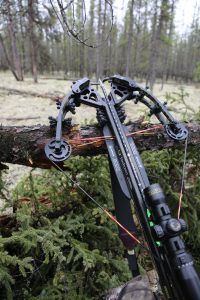I bristled with excitement as an extremely large black bear meandered through the stunted pine trees. I steadied my crossbow on my shooting sticks and settled in behind the scope to obscure myself as the bruin drew closer. When I was finally presented with the perfect shot angle, I gently squeezed the trigger and heard the release of my string as the broadhead found hide. The sound of the broadhead slicing through flesh was fast. The arrow went completely through the bear and was lodged in the ground 20 yards beyond the point of impact. To say my bow and arrow combination produced enough kinetic energy to get the job done is an understatement.
Kinetic energy is one of the most important things to understand when toting a horizontal or vertical bow. Kinetic energy is produced by all moving things. It is the energy found in an object due to its motion or movement.
Everything that moves has kinetic energy, and, for crossbow enthusiasts, it’s important to remember that the heavier your arrow and broadhead are and the faster the combo moves, the more kinetic energy it carries. That might be difficult to get your head around considering bows are shooting faster than ever and arrows are getting lighter and smaller as technologies evolve. Historically, bows shot slow (compared to today’s standards). While the bows of yesteryear don’t have the range of their modern-day cousins, heavy arrows and broadheads penetrated with no problem.
What Are The Minimums?
Before heading out on a spring turkey or bear hunt, consider minimum draw weight and kinetic energy. Most jurisdictions have regulations to ensure enough draw weight is used on a crossbow to produce kinetic energy that kills cleanly. It can seem like a complicated game of picking the right crossbow speed, arrow weight, broadheads and standards for killing a bruin or other game. It all boils down to kinetic energy, which, in the archery world, is measured in foot pounds.
Do The Math
You can quickly determine the kinetic energy of your crossbow arrow with this simple calculation:
Speed (fps) X speed (fps) X arrow weight (grains) ÷ 450,240 = foot pounds of kinetic energy
Let’s have a quick look at how speed, arrow weight and bow design would change kinetic energy and, ultimately, the effective range of different equipment. If we look at some of the popular crossbow models available today and match them with arrows based on the manufacturer’s recommendations for draw length and draw weight, we can quickly see the kinetic energy produced. I like to use a chronograph to measure the speed that a specific bow would shoot an arrow to calculate the exact kinetic energy for any combination of bow, arrow and broadhead I use.
The TenPoint Nitro RDX has a 165-pound draw weight. Using TenPoint Pro Elite carbon arrows with 100-grain practice points, the bow produces 122 foot pounds of kinetic energy. The Pro Elite is a 20-inch 22/64 diameter carbon fiber arrow. It is fitted with a 68-grain brass insert and has a standard-weight of 425 grains. To be clear, 122 foot pounds will blow clean through even the most heavy-boned game at extended distances if the arrow is placed in the vitals.
Wicked Ridge’s Invader G3 also has a draw weight of 165 pounds. Shooting Wicked Ridge Carbon Arrows with 100-grain practice point produces 96 foot pounds of kinetic energy. The arrows weigh 400 grains including the field point.
These bows boast the same draw weight, but have a 25-grain difference in arrow and broadhead weight. The outcome is 26 foot pounds of more kinetic energy in the Nitro RDX, because of the extra weight.
What Does It All Mean?
Looking back at the archery world, let’s revisit a hunt by bowhunting pioneer and legend Fred Bear. I use this comparison often, as Fred got within 65 feet of a big grizzly before drawing his 50-pound recurve and placing an arrow into the animal’s vitals. The recurve simply doesn’t compare in speed or performance of any crossbow on the market today, but it worked. Why? Fred’s bow would have shot an arrow at about 150 feet per second, but if you were to ask most archers today what the minimum speed is for hunting effectively, they’d likely answer between 230 and 285 fps. As for the grizzly that Fred shot? It died a short distance away from where it had been feeding — a good reminder that the speed of your bow isn’t everything.
What Is Enough?
A review of Fred’s recurve, arrow and broadhead selection places his kinetic energy somewhere around 32 foot pounds, which is more than enough to kill effectively. However, Fred was a real believer in the hunt and always stalked to close range before making a shot. My TenPoint will blaze an arrow through a deer or bear at 20 yards and still provide enough kinetic energy for the arrow to continue in flight and bury itself into the ground or obstacle in the distance. It also provides me with more kinetic energy at greater distances, which is really important.
Most archers today don’t have a minimum shooting range of 20 or 30 yards. Why? Because they don’t have to. Today’s horizontal wonders produce plenty of energy to smash through feathers or bone and ensure a straight flying arrow will equate to fresh protein in the freezer.
Crossbows offer the best of both worlds when it comes to arrow speed produced by greater draw weights. Lighter arrows fly faster, but they don’t offer the same energy. The quick fix for anyone who might be worried is to use a heavier arrow and broadhead. The combination will cut into your speed, but it will produce devastating results. And, let’s face it, most turkeys and bears are shot at 25 yards or less, so do you really need more speed?







